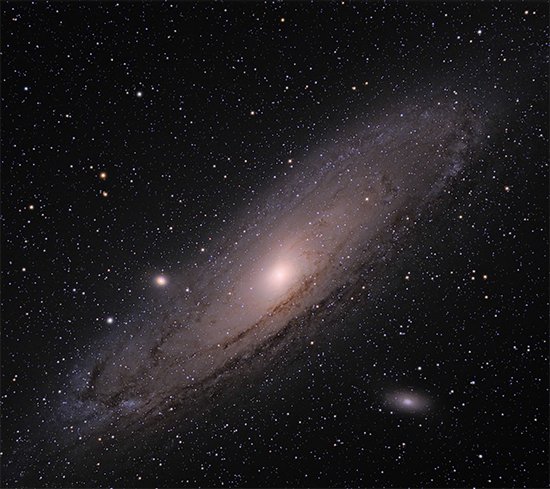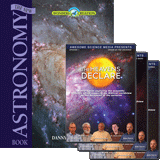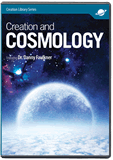Dark Matter—What’s the Matter?
As we gaze into the heavens to understand more about our universe, we find evidence for something vast yet invisible. Though shrouded in mystery, dark matter is more than myth.
Look around at the water, rocks, plants, animals, and other humans. Grab a telescope and take a peek at the planets, galaxies, and other stellar wonders. Now squint through a microscope at the infinitesimal world of bacteria, fungi, and other organisms. You could look for a lifetime and still not see everything there is to see. But incredibly, astronomers believe that about 90% of matter in the universe is invisible. They call it dark matter.
You’ve probably heard of dark matter in the news or in science fiction. Yet despite our familiarity with the term, dark matter remains the greatest unsolved problem in physics, because its identity remains unknown. Physicists have an elaborate theory for the various types of particles that exist. But none of the known particles seem to explain dark matter, neither does there appear to be room for new particles that can be dark matter. We know much about how the universe works, but it is startling to realize that we don’t know what makes up most of the universe. The person who successfully solves this puzzle is assured a Nobel Prize.
But evolutionists face the challenge head on, frequently invoking dark matter in their ideas about astronomy and cosmology (the study of the structure of the universe). For instance, evolutionists believe dark matter plays a vital role in the formation and long-term maintenance of galaxies. And dark matter seems to be necessary to solve some problems with their big bang model.
Because of its mysterious nature and its uses in evolutionary models, some biblical creationists view dark matter as merely a fabricated rescuing device in evolution’s storytelling. But the evidence for dark matter showed up long before the dominance of the big bang model or the modern secular explanation of how galaxies form and are structured. In reality, dark matter, with all its mystery, is an undeniable aspect of creation that showcases the Creator’s glory.
Dark Matter Comes to Light
The first evidence for dark matter came in 1937, when the Swiss-American astronomer Fritz Zwicky published a study of the Coma Cluster of galaxies. A little more than 300 million light-years from earth, the Coma Cluster has at least 1,000 galaxies apparently orbiting a common center of mass under the influence of the galaxies’ mutual gravity. Since gravitational force depends upon mass, Zwicky measured how fast the galaxies were orbiting to determine the dynamic mass of the Coma Cluster. Zwicky also estimated the lighted mass of the Coma Cluster by measuring the brightness of its galaxies. More mass implies more stars, resulting in greater brightness. Thus, the brightness of galaxies reveals their masses.
When Zwicky compared the mass of the Coma Cluster measured these two different ways, he was astonished to find they were very different—the dynamic mass was about 10 times greater than the lighted mass. Zwicky soon extended his study to other galaxy clusters. He found that their dynamic masses exceeded their lighted masses by similar amounts. This suggested that much of the mass of galaxy clusters was not visible. The invisible matter revealed its presence only through its gravitational interaction. This discovery illuminated the trail to dark matter.
Just two years later in 1939, additional evidence for dark matter showed up when Horace Babcock published a rotation study of M31, the Andromeda Galaxy. Since we view M31 nearly edge-on, stars on one side of the galaxy move toward us as they orbit the galaxy’s center, while stars on the other side move away from us. By looking at the distribution of light, we can infer how matter is distributed in M31. This knowledge allows us to predict the orbital velocity of stars on either side of a galaxy’s center. In the nucleus (the bright oval near M31’s center), velocities ought to increase linearly with increasing distance from the center, but outside the nucleus, the velocities ought to taper toward zero at great distance from the center.
Babcock used the Doppler effect (a subtle difference in the light waves of stars due to their motion) to measure orbital velocities across the long axis of M31. In the galaxy’s nucleus, the velocities were as he predicted. But outside the nucleus, velocities did not decrease as Babcock expected. Rather, orbital velocities remained high and even increased slightly, suggesting much mass far from the center of M31, where there was very little light. How much of this dark matter was required to explain the orbital motion? The same factor of 10 that Zwicky had encountered in the Coma Cluster.

Photo by JIM AND DEB BONSER
The Andromeda Galaxy was one of the first galaxies where dark matter was discovered.
The Greatest Unsolved Problem
Though shocking, these two lines of evidence for dark matter didn’t seem to attract much attention among astronomers. After World War II started, many astronomers were distracted when they enlisted into research and development for the military. Because these two fields were pushing the limits of what was possible in observational astronomy at the time, perhaps astronomers assumed that they couldn’t yet explore dark matter any further. However, the lack of interest more likely stemmed from their failure to grasp the significance of dark matter.
At any rate, dark matter remained merely a minor curiosity for three decades. By 1970, technology had advanced enough to feasibly revisit Babcock’s work with M31 and to expand the research to other galaxies. Two astronomers, Vera Rubin and Kent Ford, embarked on a decade-long collaboration that not only verified Babcock’s unusual result for M31 but also found similar results in all the galaxies that they studied. It seemed that about 90% of the mass of galaxies—hence the universe—was invisible.
If 90% of the universe’s mass is invisible, then what is it?
But astronomers are a stubborn bunch. Not until well into the 1980s did they come to grips with this fascinating problem. If 90% of the universe’s mass is invisible, then what is it? It couldn’t be in the form of faint stars, because those faint stars would be visible. Nor could it be normal matter in some other form, such as dust. Even dust shows up in the infrared part of the spectrum, but the dust we see in the infrared is not nearly enough to account for all that dark matter.
If observations eliminate “normal” matter, then dark matter must be in some other, exotic form. Normal matter that we encounter every day consists of protons, neutrons, and electrons. But physicists are aware of many other types of exotic matter, such as neutrinos. Over the past three decades, physicists have proposed all sorts of particles, both known and hypothetical, to account for dark matter. Various experiments have looked for these particles, but all results so far have been negative. Dark matter remains a mystery.
The Rescuing Device
Cosmologists (those who delve into the philosophical side of the origin of all things) accepted dark matter even later than astronomers did. Though cosmologists didn’t usually include dark matter in their models prior to the 1990s, they did see earlier hints of dark matter’s necessity. In a theoretical paper in 1973, Jerry Ostriker and James Peebles showed that spiral galaxies could not exist with the matter distribution implied by their light alone. But the addition of dark matter, as suggested by Zwicky more than 35 years earlier, solved this problem.
In 1982, Peebles showed that, to account for the universe’s existence, the big bang model might need much additional unseen matter moving much slower than the speed of light. This proposal came to be called cold dark matter, or CDM for short. Two years later, to account for what we see, Peebles added an acceleration term to the expanding universe in the big bang model. A century ago, Einstein introduced a similar acceleration term into his model of the universe. (It proved to be unpopular with other cosmologists, and he eventually retracted it.) Since Einstein had called his expansion term Λ (the Greek letter lambda), Peebles’ model became known as the ΛCDM model. No one took the ΛCDM model too seriously until two decades ago when cosmologists discovered evidence that the expansion of the universe is accelerating. Since then, the ΛCDM has been the dominant cosmology.
Casting Shade on Dark Matter
For the past two decades, astronomers and cosmologists have primarily discussed dark matter when considering how the universe came to be. Understandably, creationists might think that the argument for dark matter is entirely driven by its necessity in cosmological models. But this assumption overlooks the significant research conducted on dark matter using observational astronomy, prior to the relatively recent years when cosmologists invoked dark matter to explain how the universe evolved. Zwicky, Babcock, Rubin, and Ford were not motivated by cosmological considerations but were concerned merely with the observational data. In other words, dark matter became a ready lifeline for big bang cosmologists only after being established as a reality.
Long before cosmologists were making the historical science argument for dark matter, observational science made a strong case for dark matter.
In light of dark matter’s history, creationists’ skepticism about its reality seems unfounded. We creationists often make a distinction between observational science and historical science. These two uses for science vary greatly, with different rules of evidence. We have little disagreement with secular scientists when it comes to observational science, which studies how the world works in the present. We disagree, however, on historical science because it attempts to study past processes. After all, the past is past and cannot be directly observed and tested the way that science in the here and now can be tested. Historical science employs worldview to interpret the past. So evolutionists use historical science to implement dark matter in the process of the universe’s evolution.
Most discussion about dark matter now comes from the historical science position. But long before cosmologists were making the historical science argument for dark matter, observational science made a strong case for dark matter. Creationists ought to embrace this history and move forward researching this aspect of God’s creation.
The Deep Mysteries of the Creator
So what is dark matter? I don’t have a clue. If I did, I’d have a Nobel Prize, now wouldn’t I? The more we learn about creation, it seems the less we know. Dark matter is just one of the universe’s mysteries we have to figure out. And there’s no reason that a creationist might not uncover the answer, starting with God’s Word as their foundation.
Such mysteries about the physical world should cause us to realize how deep the mysteries of God go. We will have all eternity to probe and continually discover more about God’s attributes. For now, our attempt to learn more about his glory by studying his creation is just peering through a telescope glass darkly, a dim picture of the majesty that lies ahead for God’s people.
Answers Magazine
July–August 2020
It’s always nice to have something as humble as the llama helping to guard the truth of God’s Word.
Browse Issue SubscribeRecommended Resources

Answers in Genesis is an apologetics ministry, dedicated to helping Christians defend their faith and proclaim the good news of Jesus Christ.
- Customer Service 800.778.3390
- © 2024 Answers in Genesis







